Team:Evry/Tadpole injection1
From 2012.igem.org
| Line 7: | Line 7: | ||
<br/> | <br/> | ||
<p> | <p> | ||
| + | |||
| + | In order to test ours plasmids we injected it into fertilized eggs, then we followed the expression of fluorescence during time and dépending on specific tissue (is the promoter is tissue specific).<br/> <br/> | ||
Embryos and tadpoles were not fed during all the week of experiment, they grew up with their own vitellus.<br/> | Embryos and tadpoles were not fed during all the week of experiment, they grew up with their own vitellus.<br/> | ||
Revision as of 18:08, 25 September 2012
Characterization of injected plasmid into Xenopus tropicalis eggs
In order to test ours plasmids we injected it into fertilized eggs, then we followed the expression of fluorescence during time and dépending on specific tissue (is the promoter is tissue specific).
Embryos and tadpoles were not fed during all the week of experiment, they grew up with their own vitellus.
Pictures were taken with the Zeiss stereomicroscope: SteREO Lumar V12 with the camera AxioCamMRm.
The injection tutorial explains very simply with diagram how we did the injections and how to take care about your embryos and tadpoles. The experiment carries on 5 days, from the unfertilized egg to a swimming tadpole at stage 48-50. The GFP (or other fluorescent protein) is expressed few hours after the fertilization to the end of the week (see below).
The iGEM-Evry tem say a great thanks to Dr. Nicolas Pollet, Dr. Aurore Thelie and Lena Vouillot (PhD student) who teach us how to inject embryos, take care of tadpoles and how to use their microscope. They are from Institute of Systems & Synthetic Biology of Evry in the Metamophosys group.
Plasmids injected:
We injected 2.3 nl of plasmid at 100ng.µl-1 - embryos were stored at 21°C during all the experiment.
- pCS2+ elastase sfGFP: contains the tissue specific promoter elastase and the fluorescent protein sfGFP, elastase is a promoter specific to pancreas. This Biobrick created by our team is BBa_K812233 (ready to use in Xenopus). This plasmid was built from the eukaryotic plasmid (with elastase promoter) BBa_K812200 and the Biobrick with the sfGFP (with the Kozak sequence) BBa_K812031. Number of Plasmids injected: ~ 5.27E+7
- pCS2+ GFP-aid: contains the constitutive promoter CMV and the aid sequence of the aid system fused to GFP (Green Fluorescent Protein)(Nishimura et al., 2009), this Biobrick created by our team is BBa_K812110 (ready to use in Xenopus). This plasmid was built from our pCS2+ eukaryotic plasmid BBa_K812000 with the GFP-aid BBa_K812010.. Number of Plasmids injected: ~ 3.78E+7
- pCS2+ citrine: contains the constitutive promoter CMV and the fluorescent protein citrin (yellow), the plasmid BBa_K812130 (ready to use in Xenopus) is from our pCS2+ eukaryotic plasmid BBa_K812000 with the YFP (with the Kozak sequence) BBa_K812030. Number of Plasmids injected: ~ 4.38E+7
- pCS2+ mCFP: contains the constitutive promoter CMV and the fluorescent protein mCFP (Cyan Fluorescent Protein). the plasmid BBa_K812132 (ready to use in Xenopus) is from our pCS2+ eukaryotic plasmid BBa_K812000 with the YFP (with the Kozak sequence) BBa_K812032. Number of Plasmids injected: ~ 4.37E+7
- pCS2+ sfGFP: contains the constitutive promoter CMV and the fluorescent protein sfGFP (super folded Green Fluorescent Protein). the plasmid BBa_K812133 (ready to use in Xenopus) is from our pCS2+ eukaryotic plasmid BBa_K812000 with the sfGFP (with the Kozak sequence) BBa_K812031. Number of Plasmids injected: ~ 4.37E+7
- pCS2+ elastase sfGFP
- pCS2+ GFP-aid
- pCS2+ citrine
- pCS2+ mCFP
- pCS2+ sfgFP
Tadpole are at stage 47. Their size is near 5 mm.

We can see a sfGFP expression in a region close to intestine and biliar vesicle, and i is not auto-fluorescence It could be the pancreas but pancreas is small in the tadpole and it is not easy to determine. This injection will be done again to have strong results.
24h after injection
Embryos are near stage 20, neural fold is visible and the size of neurulas is near 1 mm

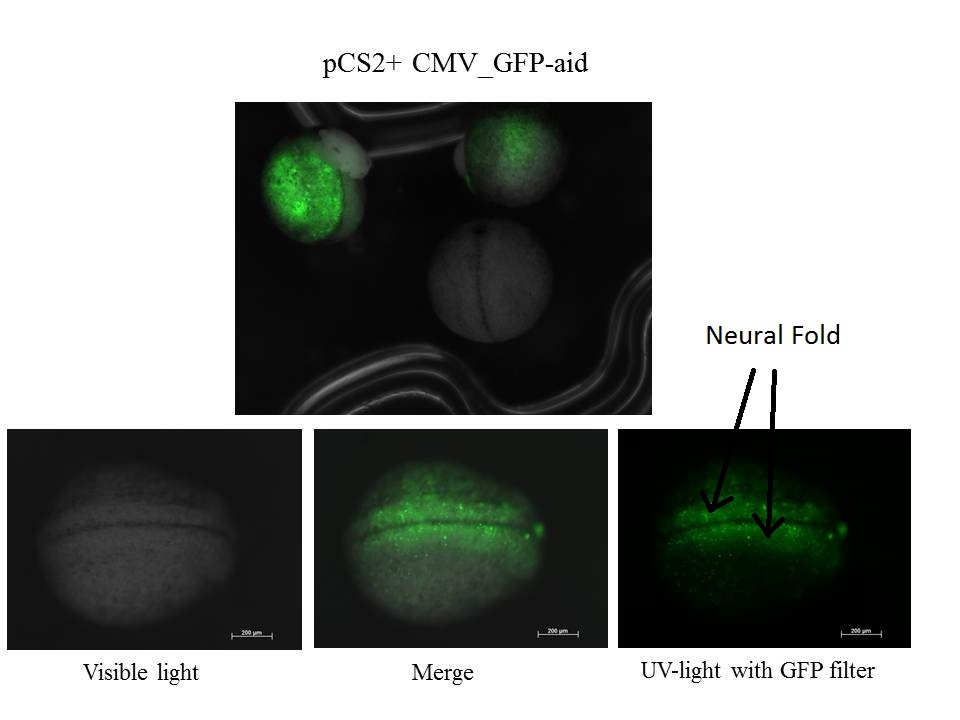
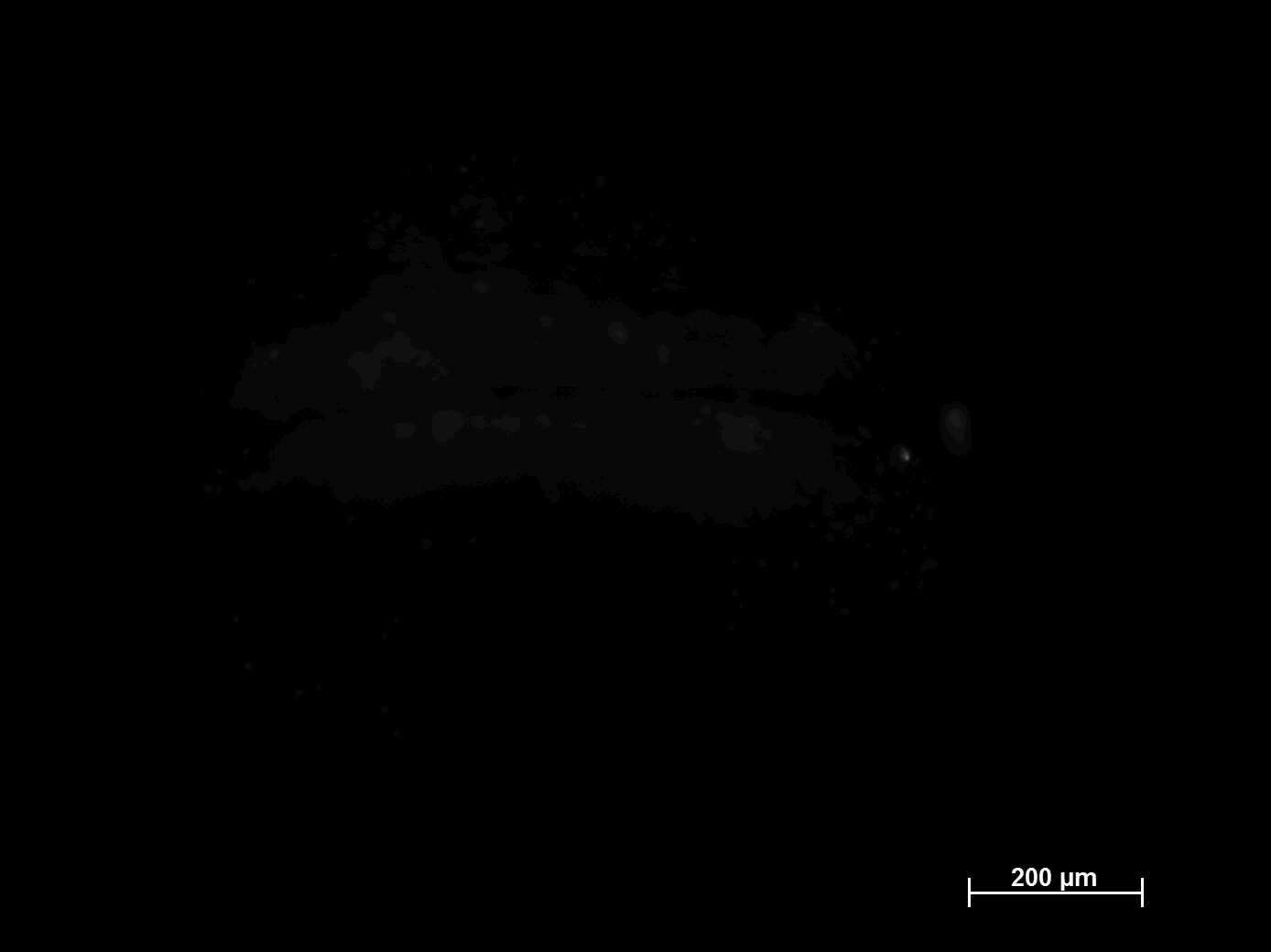
z-stack of the embryo
48h after injection
Embryos are at stage 34-38 and move by intermittence, the size of tadpole is near 2.5 mm
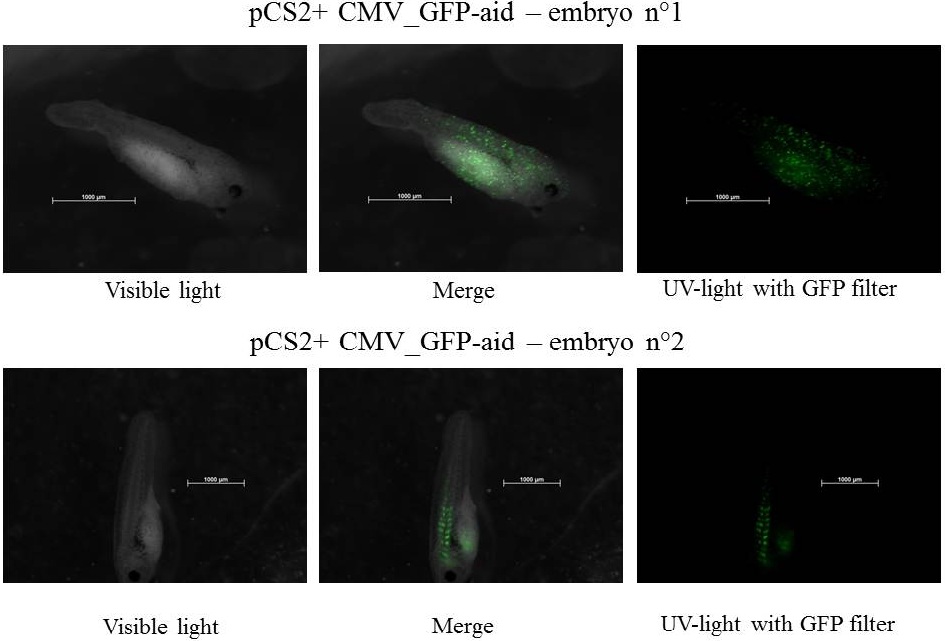
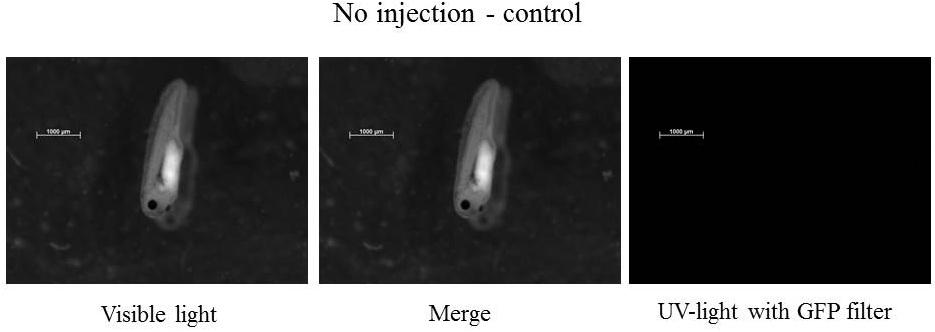
The expression of GFP-aid is localized in different tissue for each tadpole, in spite of the promoter is constitutive (CMV). We can think that the plasmid does not diffuse in the eggs because of the vitellus viscosity. This question was raised in one of the modelling part
3 days after injection
Embryos are at stage 41-42 and swim, the size of tadpole is near 4 mm.
From this tadpole stage an anaesthetic is required to take pictures of tadpoles, otherwise the light teases tadpoles, and it is impossible to take a picture

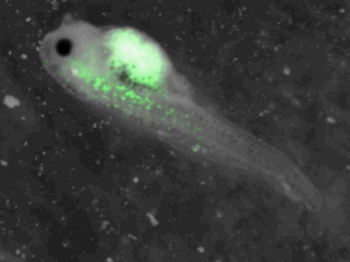
z-stack pictures: pCS2+ CMV_GFP-aid, GFP expression is not in same tissue between tadpoles: for example the tadpole on the left picture bones of the tail produced GFP, on the right picture the GFP expression is localized in the skin. The only part of the tadpole moving is the heart beatting (between the head and the stomac)
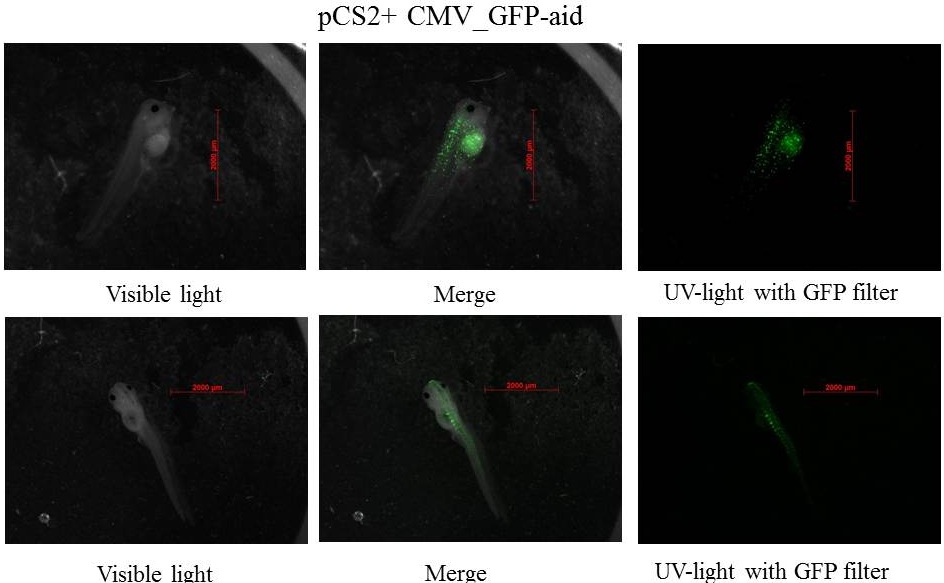

The expression of GFP-aid is localized in different tissue for each tadpole, like the day before. GFP is present in same tissue, it means that the plasmid stays in the same cells.
4 days after injection
Embryos are at stage 45-46 and swim, the size of tadpole is near 5 mm.


The GFP is still present in specific tissue, but also the GFP is decreasing. Plasmids could be ruined by cells, and/or the quantity of plasmids could decrease in each cells which involded the diminution of GFP in each cells, after that it is more difficult to see GFP. picture with the LSM 510 META Laser Scanning Microscope from Zeiss.
A great thank to Dr Daniel Stockholm and Genethon for using this microscope.
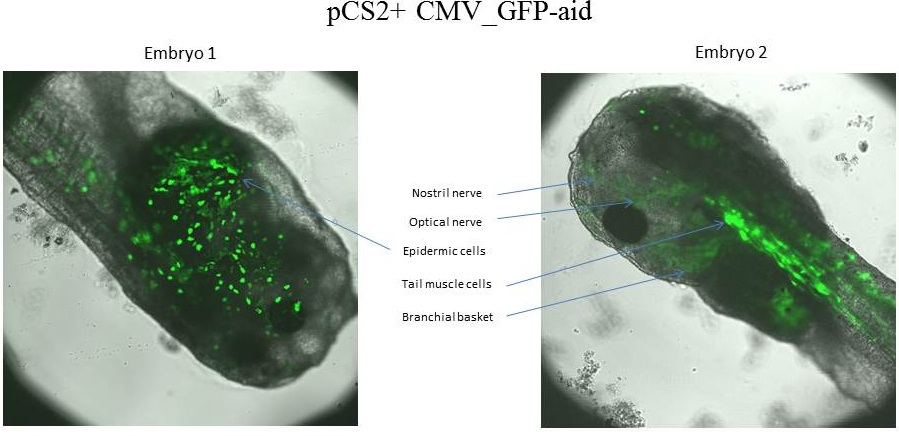
The tadpole 1 express GFP-aid in epidermic cells, whereas the tadpole 2 express GFP-aid in optical nerve,nostril nerve, tail muscle cells and branchial basket.
Tadpole have 4 days (stage 45-46), because our lab does not have YFP filter the LSM 510 META Laser Scanning Microscope from Zeiss was used.
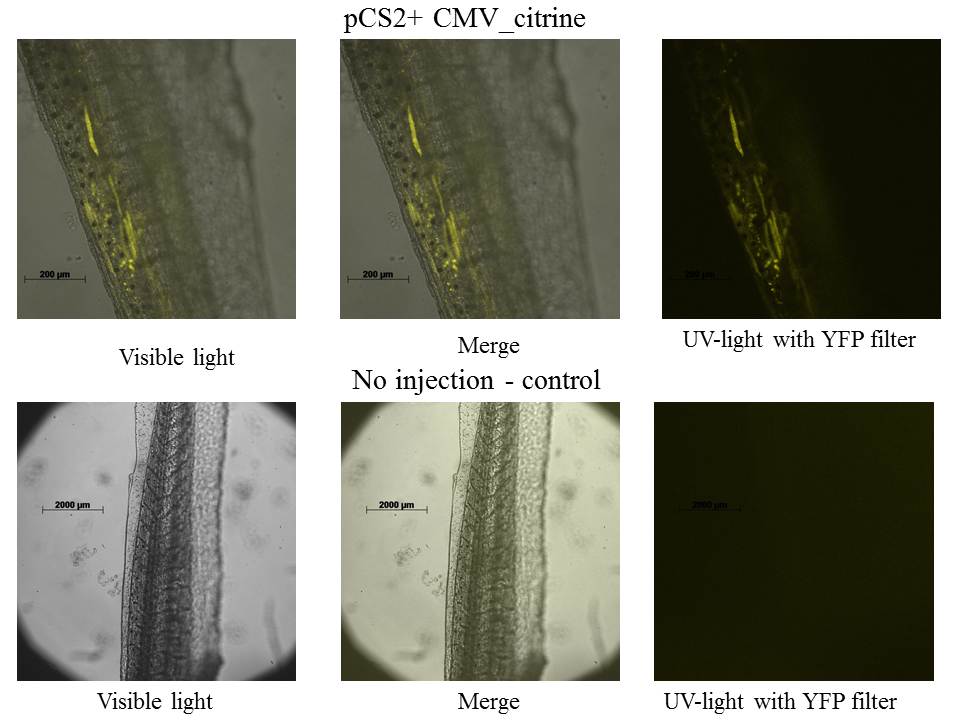
The expression of mCitrine is localized in tail's muscles.
Tadpole 1 is 2 days (stage 36-38), the expression of CFP is localized in intestine. Tadpole 2 is 4 days (stage 45-46), the expression of CFP is localized in Branchial basket and intestine.


The expression of sfGFP is present only in one of both embryo/tadpole, maybe because the "white" tadpole was not injected. sfGFP is present only in few tissue as others reporters. sfGFP is expressed in tail's muscles and branchial basket for this tadpole.
Conclusion
This page shows that our construction express our reporter with the CMV promoter. This part are considered characterized. Nevertheless we expected an uniform expression of reporter with the CMV promoter. Colors fluorescent proteins was expressed in different tissue specific, one tadpole expresses the colors fluorescent protein into one to four different tissues, and tissue are different between tadpoles.
Explanation: The plasmid does not diffuse in the egg and stay in the same area, it means that depending on the injection area the plasmid would be in a part of the tadpole. This question was raised in our model. An other reason could be that the metabolism of each tissue specific cell is different and change during the tadpole's development.
Moreover the expression of reporters decrease during times, because plasmids are damaged during times but also plasmid are divided in more cells and the quantity of plasmids decrease for each cell.
References:
- Inducible control of tissue-specific transgene expression in Xenopus tropicalis transgenic lines., Chae J., Zimmerman L.B., Grainger R.M., Mechanisms of development 117:1-2, 2002
- Xenopus: a prince among models for pronephric kidney development., Jones E., JASN 16:2, 2005
- An auxin-based degron system for the rapid depletion of proteins in nonplant cells, Nishimura K., Fukagawa T., Takisawa H., Kakimoto T., Kanemaki M., Nature Methods 6:12, 2009
 "
"